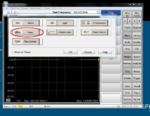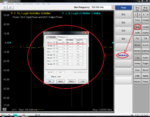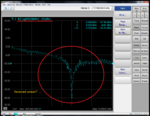Nia11
Newbie level 5
- Joined
- Jun 14, 2016
- Messages
- 10
- Helped
- 0
- Reputation
- 0
- Reaction score
- 0
- Trophy points
- 1
- Location
- Paris,France
- Activity points
- 87
Hi,
I need to measure the received power of the wifi antenna using vna.
VNA used- M9370A keysight.
Receiver antenna specifications– omni directional whip antenna
• 2.4-2.5GHz
• 2.15dBi gain
I connected port 2 of vna with the receiver antenna while the port 1 is connected to the 50 ohm load.
I have to measure the amount of power received by the antenna that is connected to the vna.
I don’t know much details about the transmitter, The only thing I know is that the transmitter is a wifi patch antenna
In the vna, I choose the dBm power option instead of s parameter to measure the power received by the receiver antenna. I have attached the figures of the vna window screen along with the post.

Since I connected my receiver to port 2, I selected Meas -> Receivers -> Activate-> B, you could see that in the attached figure 2.


The resulting figure shows the received power in dBm, which is -27.15dBm @ 2.4 GHz.
The problem is when I convert the power in dBm (-27.15dBm) to watts, I get very small power value that is equal to 0.00192 mw or 1.92 µw.
Is the measurement procedure is wrong? Or this the actual power received?
(p.s- I didn’t do the measurements in anechoic chamber), Thank you in advance.
I need to measure the received power of the wifi antenna using vna.
VNA used- M9370A keysight.
Receiver antenna specifications– omni directional whip antenna
• 2.4-2.5GHz
• 2.15dBi gain
I connected port 2 of vna with the receiver antenna while the port 1 is connected to the 50 ohm load.
I have to measure the amount of power received by the antenna that is connected to the vna.
I don’t know much details about the transmitter, The only thing I know is that the transmitter is a wifi patch antenna
In the vna, I choose the dBm power option instead of s parameter to measure the power received by the receiver antenna. I have attached the figures of the vna window screen along with the post.

Since I connected my receiver to port 2, I selected Meas -> Receivers -> Activate-> B, you could see that in the attached figure 2.


The resulting figure shows the received power in dBm, which is -27.15dBm @ 2.4 GHz.
The problem is when I convert the power in dBm (-27.15dBm) to watts, I get very small power value that is equal to 0.00192 mw or 1.92 µw.
Is the measurement procedure is wrong? Or this the actual power received?
(p.s- I didn’t do the measurements in anechoic chamber), Thank you in advance.
